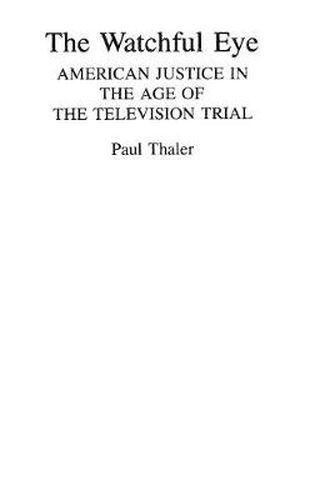Readings Newsletter
Become a Readings Member to make your shopping experience even easier.
Sign in or sign up for free!
You’re not far away from qualifying for FREE standard shipping within Australia
You’ve qualified for FREE standard shipping within Australia
The cart is loading…






According to Thaler, the presence of cameras in the courtroom is a pervasive technology that can affect public perceptions of the judicial process, change the behavior and attitudes of trial participants, and ultimately transform the sober process of justice into a media event designed for maximum public exposure. The author has interviewed more than 50 people–prominent journalists, academics, and members of the legal system–and brought together their observations in a fascinating historical and psychological profile of the televised courtroom. Thaler provides a historical overview and theoretical perspective, and discusses the new cable courtroom network and the current and continuing camera debate in New York City. He makes reference to the recent celebrated cases involving Amy Fisher, William Kennedy Smith, and Rodney King, then turns to an in-depth case study of the Joel Steinberg murder trial, including insights from the presiding judge, trial attorneys, witnesses, jurors, and the defendant himself, as well as journalists who covered the trial. The author concludes that the process of justice is slowly being turned into an entertainment vehicle, not unlike the show trials of bygone eras.
$9.00 standard shipping within Australia
FREE standard shipping within Australia for orders over $100.00
Express & International shipping calculated at checkout
According to Thaler, the presence of cameras in the courtroom is a pervasive technology that can affect public perceptions of the judicial process, change the behavior and attitudes of trial participants, and ultimately transform the sober process of justice into a media event designed for maximum public exposure. The author has interviewed more than 50 people–prominent journalists, academics, and members of the legal system–and brought together their observations in a fascinating historical and psychological profile of the televised courtroom. Thaler provides a historical overview and theoretical perspective, and discusses the new cable courtroom network and the current and continuing camera debate in New York City. He makes reference to the recent celebrated cases involving Amy Fisher, William Kennedy Smith, and Rodney King, then turns to an in-depth case study of the Joel Steinberg murder trial, including insights from the presiding judge, trial attorneys, witnesses, jurors, and the defendant himself, as well as journalists who covered the trial. The author concludes that the process of justice is slowly being turned into an entertainment vehicle, not unlike the show trials of bygone eras.